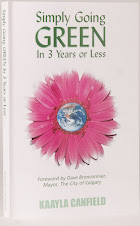It seems that Going Green is what is on more and more peoples minds now a days. It is pretty easy to understand, with the ever increasing cost of heating homes, or air conditioning homes, depending where you live. As well as electricity to run all those appliances, and then there is the cost to running a vehicle. How does a family survive in this economic climate, and still put food on the table?
Start by doing all the simple things:
1. Unplug any appliance that is not in use, and does not need to keep time. Then purchase SMART power bars, that let you plug in alarm clocks and DVD players - that way when you turn off the power, the essentials (alarm clock) are still plugged in.
2. Cut back on water consumption by installing low flow toilets and faucets. Only turn the water tap on to the size of a pencil stream, when washing your hands. Use a glass of water for brushing your teeth. Limit the amount of time you spend in the shower to less than 5 mins - aim for 3 mins.
3. Only purchase Energy efficient appliances. Check with Energy Star to find out how your appliances rate.
4. Install weather stripping on your doors and caulk the windows.
5. Keep blinds closed during the day on hot, sunny days in the summer to keep it cool. In the winter, open the blinds to help warm the house.
6. Recycle everything that you possible can. Reuse or find new uses for anything that can be reused. Donate clothing, magazines, books etc to charities.
7. Change the furnace filter, and get ready for winter.
8. Grow your own vegetables and fruit, in your back yard. If you live in an appartment, then do container gardening. Many vegetables like lettuce, tomatoes, onions, even carrots can be grown in containers.
9. Compost your vegetable peelings and use it in your garden.
10. Get a rain barrel and use it.
11. Get your vehicle tuned up and have all the fluids either changed or topped up. Only drive your vehicle when you have saved up your errands and can get them all done at once.
12. Use public transportation, bike or car pool to get to work.
13. Shop for clothing at second hand stores or thrift stores. Infact, you can find many other things there, so take a look around.
14. Install a programable thermostat, and use it. Put a sweater on when your cool.
15. Line dry your clothing, if your community allows it. Only wash a load of clothes when it is full. Consider getting a front loading washer, as it uses less water, and electricity.
16. Opt out of junk mail getting delivered.
17. Install LED lights.
18. Turn off the TV and get outside for a walk.
This is just a simple list of how to get started, when you go green. Consider purchasing this book
http://www.simplygoinggreen.ca/. It is full of great resources, links and information to making your going green journey easy.





